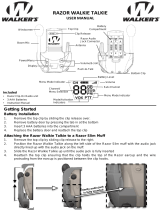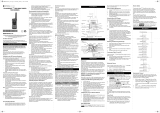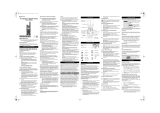Page is loading ...

Two way radio
RT15
EN
16 channel
Super receive
Vox
Monitor
Scanning
TOT
CDCSS/DCS
Strong anti-interference
Version:R20180807

Product safety and RF Exposure for two way radio:
Before using this two way radio, please
readthe manual which contains important
operating instructions for safe usage, RF
Energy Awareness, control information
and operational instructions for complia-
nce with RF Energy Exposure limits in ap-
plicable national and international stand-
ards, and also read the operational instr-
uctions for safe use.
WARNNINGS
ATTENTION!

Function Operations
--------------------------
01
Standard Accessories
------------------------
02
Optional Function
-------------------------
03
Technical Parameters
------------------------
07
Warnnings
08
--------------------------------------
Contents

Function Operations
01

Standard Accessorles
02

Optional Functions
03

Operation details
Operation details Switch to channel 7 first, then
turn off the radio. Press“CH+”key, turn on the radio
at the same time. There will be a voice "VOX ON"
or "VOX OFF".
Optional Functions
04

Optional Functions
05

Optional Functions
06

EU:400-470MHz
US:
462-467MHz
≤2W
Technical Parameters
07

This two way radio uses electromagnetic energy in the radio freque-
ncy (RF) spectrum to provide communications between two or more
users over a distance. It uses radio frequency (RF) energy or radio
waves to send and receive calls. RF energy is one form of electrom-
agnetic energy. Other forms include, but are not limited to, sunlight
and x-rays. RF energy, however, should not be confused with these
other forms of electromagnetic energy, which when used improperly,
can cause biological damage. Very high levels of x-rays, for example,
can damage tissues and genetic material.
Experts in science, engineering, medicine, health, and industry work
with organizations to develop standards for safe exposure to RF ene-
rgy. These standards provide recommended levels of RF exposure
for both workers and the general public. These recommended RF ex-
posure levels include substantial margins of protection.
All Retevis two-way radios are designed, manufactured, and tested to
ensure they meet government-established RF exposure levels. In ad-
dition, manufacturers also recommend specific operating instructions
to users of two-way radios. These instructions are important because
they inform users about RF energy exposure and provide simple proc-
edures on how to control it.
Please refer to the following websites for more information on what RF
energy exposure is and how to control your exposure to assure comp-
liance with established RF exposure limits:
http://www.who.int/en/
WARNNINGS
08

When two-way radios are used as a consequence of employment, the
Local Government Regulations requires users to be fully aware of and
able to control their exposure to meet occupational requirements. Ex-
posure awareness can be facilitated by the use of a product label dir-
ecting users to specific user awareness information. Your Retevis two
way radio has a RF Exposure Product Label. Also, your Retevis user
manual, or separate safety booklet includes information and operating
instructions required to control your RF exposure and to satisfy comp-
liance requirements.
Local Government Regulations
Governments keep the radios in classification, most of the classified
walkie-talkie need to get local government License, and operation is
allowed. The detailed classification and the use of your two radios,
please contact the local government radio management departments.
For the following specified classification: the USA FRS, Australian CB,
the individual license is not required.
Radio License
Your Retevis two-way radio is designed and tested to comply with a
number of national and International standards and guidelines (listed-
below) for human exposure to radio frequency electro-magnetic energy.
Compliance with RF Exposure Standards
(If appropriate, Reference to the actual product’s
Safety Marking)
WARNNINGS
09

FCC ID
The FCCID means: This radio complies with the IEEE (FCC) and IC-
NIRP exposure limits for occupational/controlled RF exposure envir-
onments at operating duty factors of up to 50% talk-50% listen and
is approved for occupational use only.
The CE marking means: Hereby, Shenzhen Retevis Technology Co.,
Ltd. declares that the radio equipment type RT15 is in compliance wi-
th the RED Directive 2014/53/EU and the ROHS Directive 2011/65/EU
and the WEEE Directive 2012/19/EU.The full text of the EU declarati-
on of conformity is available at the following internet address:
www.retevis.com.
IC ID
This device complies with Industry Canada license-exempt RSS stan-
dard(s). Operation is subject to the following two conditions:
(1)This device may not cause interference, and
(2)This device must accept any interference, including interference
that may cause undesired operation of the device.
In terms of measuring RF energy for compliance with these exposure
guidelines, your radio generates measurable RF energy only while it
is transmitting (during talking), not when it is receiving (listening) or in
standby mode.
WARNNINGS
10

NOTE: The approved batteries, supplied with this radio, are rated for
a 5-5-90 duty factor (5% talk-5% listen-90% standby) even though this
radio complies with FCC occupational exposure limits and may oper-
ate at duty factors of up to 50% talk.
RF energy exposure standards and guidelines
(if appropriate)
The FCCID means: This radio complies with the IEEE (FCC) and ICN-
IRP exposure limits for occupational/controlled RF exposure environ-
ments at operating duty factors of up to 50% talk-50% listen and is ap-
proved for occupational use only.Your Retevis two way radio complies
with the following RF energy exposure standards and guidelines:
•United States Federal Communications Commission (FCC), Code of
Federal Regulations; 47 CFR part 2 sub-part J.
•American National Standards Institute (ANSI)/Institute of Electrical &
Electronic Engineers (IEEE) C95. 1-2005
•IEEE Std. 1528:2013 and KDB447498, Evaluating Compliance with
FCC Guidelines for Human Exposure to Radio Frequency Electrom-
agnetic Fields.
•Institute of Electrical and Electronic Engineers (IEEE) C95.3-2002
•International Commission on Non-Ionizing Radiation Protection
(ICNIRP)
RF Exposure Compliance and Control Guidelines
and Operating Instructions
•Ministry of Health (Canada) Safety Code 6 & Industry Canada RSS-
102.
•International Electrotechnical Com-mission IEC62209-2:2010
WARNNINGS
11

To control your exposure and ensure compliance with the occupation-
al/controlled environment exposure limits, always adhere to the follow-
ing procedures.
Guidelines
•User awareness instructions should accompany the device when tra-
nsferred to other users.
•Do not use this device if the operational requirements described her-
ein are not met.
Operating Instructions
•Transmit no more than the rated duty factor of 50% of the time. To
Transmit (Talk), push the Push To Talk (PTT) button. To receive ca-
lls (listen), release the PTT button. Transmitting 50% of the time, or
less, is important because the radio generates measurable RF ener-
gy exposure only when transmitting in terms of measuring for stand-
ards compliance.
•Transmit only when people outside the vehicle are at least the reco-
mmended minimum lateral distance away from a properly installed
according to installation instructions, externally mounted antenna.
•When operating in front of the face, worn on the body, always place
the radio in a Retevis approved clip, holder, holster, case, or body h-
arness for this product. Using approved body-worn accessories is im-
portant because the use of Non-Retevis approved accessories may
result in exposure levels, which exceed the IEEE/ICNIRP occupation-
al/controlled environment RF exposure limits.
•If you are not using a body worn accessory and are not using the rad-
io in the intended use position, in front of the face or at the body in the
PTT mode or alongside of the head in the phone mode, then ensure-
WARNNINGS
12

the antenna and the radio are kept 2.5 cm(one inch) from the body w-
hen transmitting. Keeping the radio at a proper distance is important
because RF exposures decrease with increasing distance from the
antenna
Hand-held Mode
• Hold the radio in a vertical position with the microphone (and other
parts of the radio including the antenna) at least 2.5 cm (one inch)
away from the nose or lips. The antenna should be kept away from
the eyes. Keeping the radio at a proper distance is important as RF
exposure decreases with increasing distance from the antenna.
Phone Mode
•When placing or receiving a phone call, hold your radio product as
you would a wireless telephone. Speak directly into the microphone.
Electromagnetic Interference/Compatibility
NOTE: Nearly every electronic device is susceptible to electromagn-
etic interference (EMI) if inadequately shielded, designed, or otherw-
ise configured for electromagnetic compatibility.
Avoid Choking Hazard
Small Parts. Not for children under 3 years.
WARNNINGS
13

Turn off your radio power in the following conditions
•Turn off your radio before removing (installing) a battery or accessory
or when charging battery.
•Turn off your radio when you are in a potentially hazardous environm-
ents: Near electrical blasting caps, in a blasting area, in explosive at-
mospheres (inflammable gas, dust particles, metallic powders, grain
powders, etc.).
•Turn off your radio while taking on fuel or while parked at gasoline ser-
vice stations.
To avoid electromagnetic interference and/or
compatibility conflicts
WARNING
•Turn off your radio in any facility where posted notices instruct you to
do so, hospitals or health care facilities (Pacemakers, Hearing Aids
and Other Medical Devices) may be using equipment that is sensitive
to external RF energy.
•Turn off your radio when on board an aircraft. Any use of a radio must
be in accordance with applicable regulations per airline crew
instructions.
Note:
Pacemakers
WARNNINGS
14

Defibrillators or other Implanted Medical Devices Persons with pace-
makers, Implantable Cardioverter-Defibrillators (ICDs) or other active
implantable medical devices (AIMD) should:
• ALWAYS keep the radio more than 15 cm from their pacemaker
when the radio is turned on.
• Consult with their physicians regarding the potential risk of interfer-
ence from radio frequency transmitters, such as portable radios
(poorly shielded medical devices may be more susceptible to interf-
erence).
• Turn the radio OFF immediately if they have any reason to suspect
that interference is taking place.
• Do not carry the radio in a chest pocket or near the implantation site,
and carry or use the radio on the opposite side of their body from the
implantable device to minimize the potential for interference.
Hearing Aids
Some digital wireless radios may interfere with some hearing aids.
In the event of such interference, you may want to consult your hear-
ing aid manufacturer to discuss alternatives.
Other Medical Devices
If you use any other personal medical device, consult the manufactu-
rer of your device to determine if it is adequately shielded from RF
energy. Your physician may be able to assist you in obtaining this
information.
WARNING
WARNNINGS
15

Protect your hearing
• Use the lowest volume necessary to do your job.
• Turn up the volume only if you are in noisy surroundings.
• Turn down the volume before adding headset or earpiece.
• Limit the amount of time you use headsets or earpieces at high
volume.
• When using the radio without a headset or earpiece, do not place t
he radio's speaker directly against your ear
Note: Exposure to loud noises from any source for extended periods
of time may temporarily or permanently affect your hearing. The loud-
er the radio's volume, the less time is required before your hearing
could be affected. Hearing damage from loud noise is sometimes un-
detectable at first and can have a cumulative effect.
Avoid Burns
•Do not use any portable radio that has a damaged antenna. If a da-
maged antenna comes into contact with the skin when the radio is
in use, a minor burn can result.
WARNING
Antennas
•When the conductive material such as jewelry, keys or chains touch
exposed terminals of the batteries, may complete an electrical circuit
(short circuit the battery) and become hot to cause bodily injury such
Batteries (If appropriate)
WARNNINGS
16

as burns. Exercise care in handling any battery, particularly when pl-
acing it inside a pocket, purse or other container with metal objects.
•Do not disassemble the charger, that may result in risk of electrical
shock or fire.
•Do not operate the charger if it has been broken or damaged in any
way.
•Do not place a portable radio in the area over an air bag or in the air
bag deployment area. The radio may be propelled with great force
and cause serious injury to occupants of the vehicle when the air bag
inflates.
To reduce risk
•When the transceiver is used for long transmissions, the radiator and
chassis will become hot.
Long transmission
Safety Operation
•Do not use charger outdoors or in moist environments, use
only in dry locations/conditions.
WARNING
Forbid
WARNNINGS
17
/




